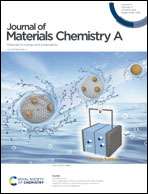Applying machine learning to boost the development of high-performance membrane electrode assembly for proton exchange membrane fuel cells†
Abstract
Recent research has proven that the incorporation of machine learning could significantly shorten the development cycle of energy materials. However, this rising multidisciplinary field still needs a standard research paradigm to instruct on how the potential of algorithms could be comprehensively exploited to optimize the performance. Hence, we set up a standard workflow consisting of four processing modules, starting with feature selection followed by decision modeling, regression modeling and extremum optimization. The optimization of the membrane electrode assembly (MEA) in proton exchange membrane fuel cells (PEMFCs) was taken as a demonstration. By applying 35 different algorithms on the largest database so far, 27 key factors out of 66 complex parameters were screened out to provide decision aids and build prediction models with errors less than 15%. Without trial-and-error processes, final optimization immediately inferred 13 optimal parameters based on existing conditions provided by users. A glimpse into the future of energy material research has therefore been brought by this great precedent.



 Please wait while we load your content...
Please wait while we load your content...